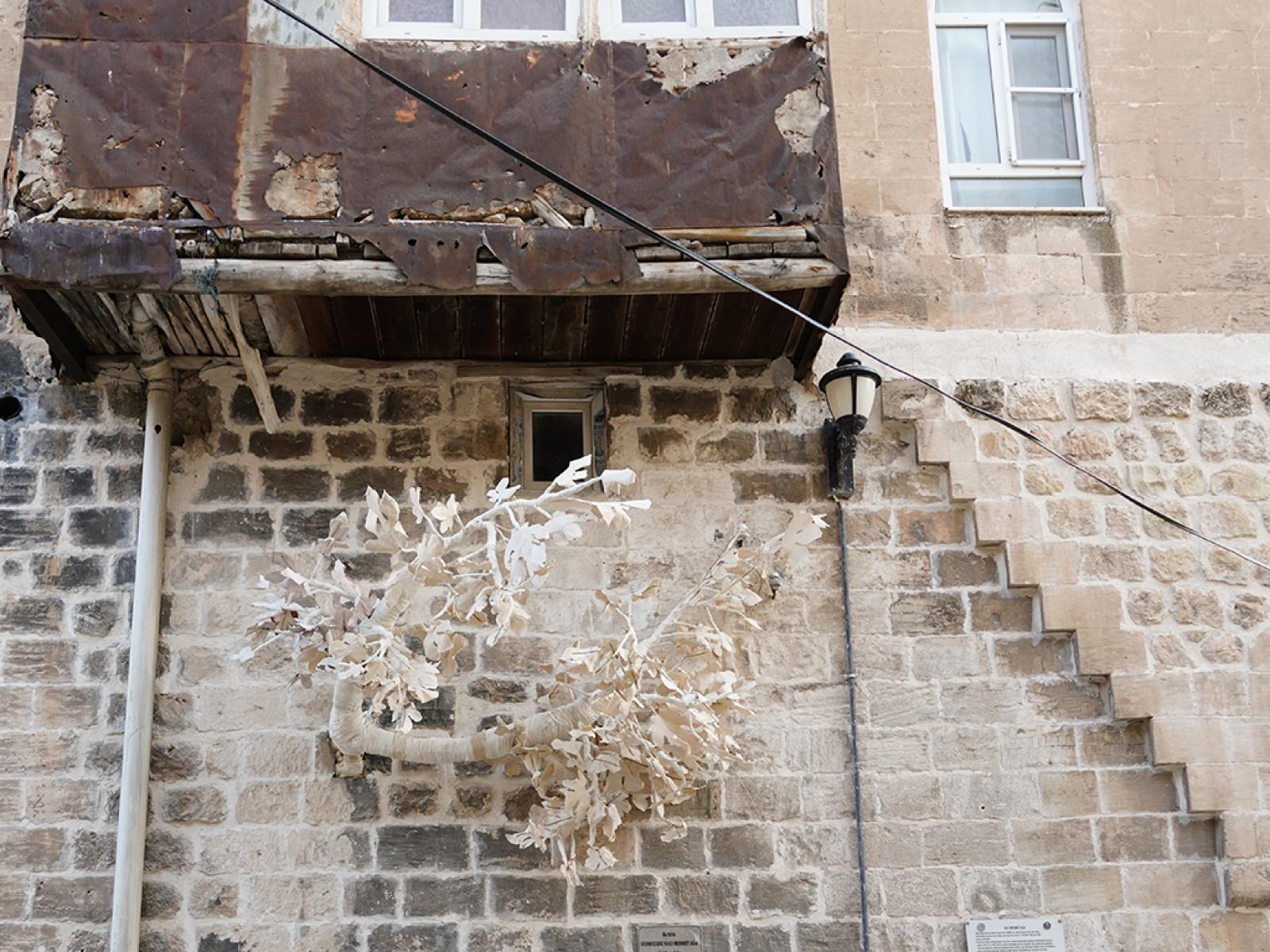
Ayhan Akikol, “Tin”, 180x200, fabric wire, paper, sponge, firmer, 2022
The cantilever on the facade of a stone house on Mardin Culture Alley was built as an extension to the house due to the inadequacy of space for the daily needs of the household. This add-on space which is covered with rusted and falling off sheet metal plates on the outside, houses a luxurious bathroom. The iron beams carrying this cantilever belong to the Narlı-Nusaybin Railroad built between 1912 and 1917. Although these rail tracks that are used as constructive elements in many of the building extensions throughout the city, are firm and safe, the common cladding materials like wood, stone, plaster and sheet metal fall off and pose danger for the vehicles parked under and people around.
In her work, inspired by the power of a fig tree growing out on the stone walls of Mardin, the artist used the natural spread of the fig tree to support the idea of an architectural extension that feels like a debris. Can we focus on the creative energy of a fig tree which receives complaints about the fruit it sheds and the walls it cracks, and which inspires the phrase “planting a fig tree in someone’s heart” meaning ruining one’s family, by reversing its destructive connotations? Is it possible to preserve a unique existence instead of destroying it? Built from newsprint, glue, wire, styrofoam and fabric, being originally “light”, the installation pursues a “heavy”/strong representation.
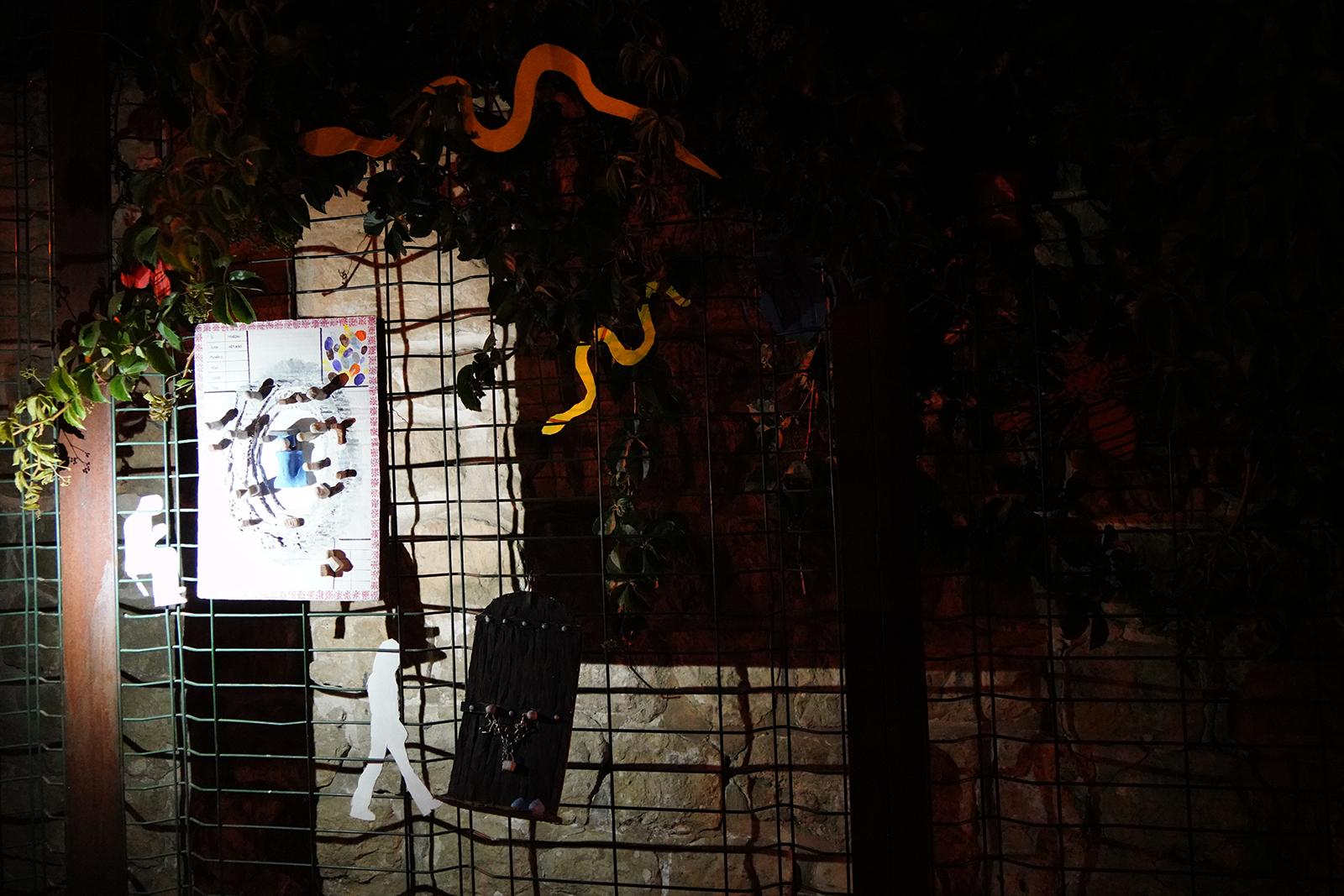
Berfin Büşra Özel, “Life”, 12 cardboard models in A3-A4 sizes, 2022
“Life” departs from an abandoned mansion that can neither be demolished nor renovated due to the disagreement between its shareholders. Life-abandoned mansions like this one are frequently encountered in Mardin old city center as the physical embodiments of inheritance problems. They witness generations of families and are the legacy of a number of family members; thus they stand aghast for years to pass. Thus the problem of share turns into a malfunction in urban space. A deep crack on the wall of a historic mansion at Üç Yol in Mardin old city center led to all the thought process for this work. The scaffolding that has been installed on the front of this mansion due to the risk of demolition has been standing untouched for years and it looks like it will so for many years to come. This scaffolding that is temporary and out-of-place has become a living habitat for an ivy. The ivy sprouts and turns green with arrival of spring, hiding the crack and making the threat behind almost invisible. “Life” takes its name from the ivy that covers a faulty situation. Scenes that I built as three and two dimensional toy like objects are placed on the scaffolding and within the ivy describing a social issue of Mardin, the problem of share, in the whole picture.
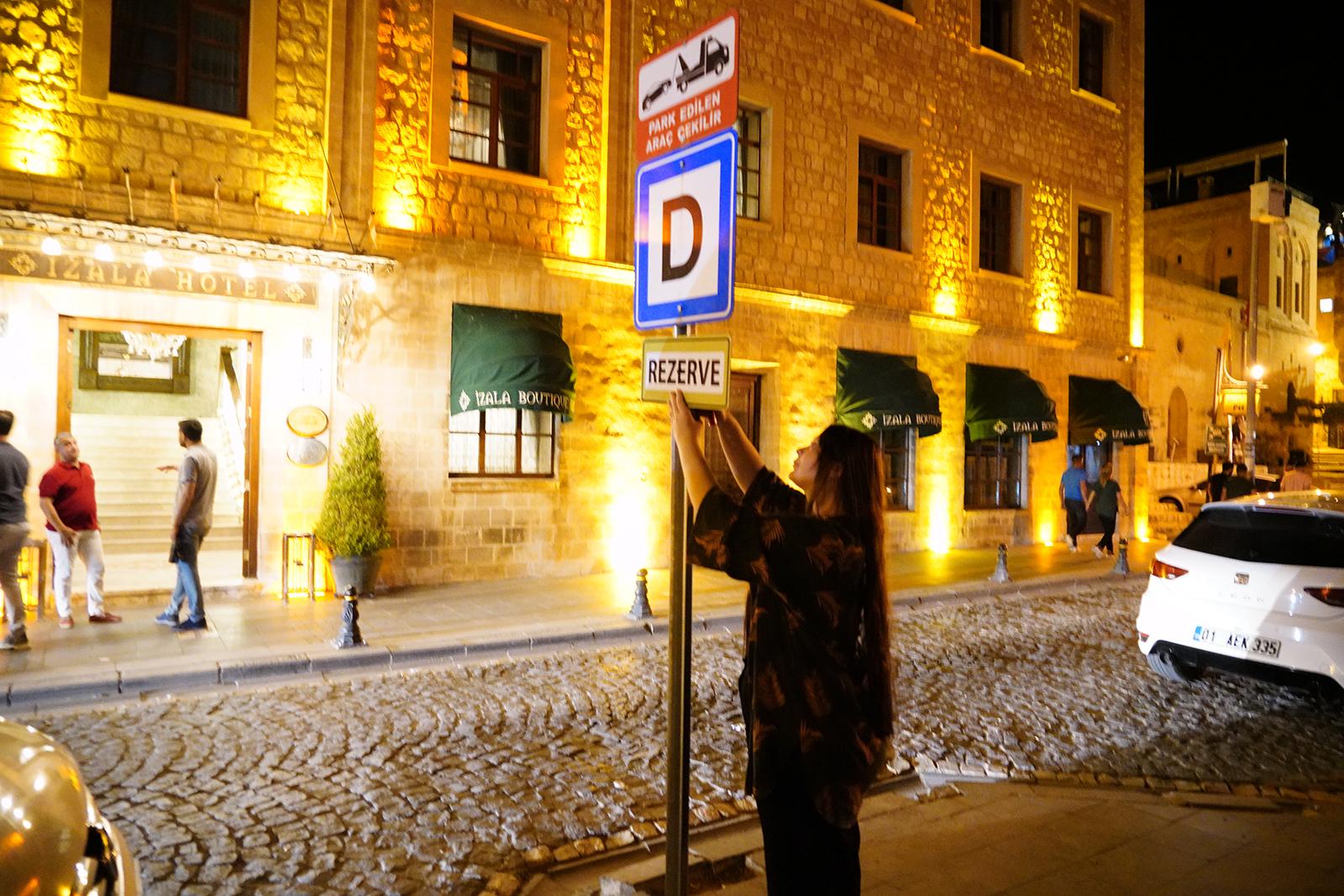
Hazel Nisa Ocak, “Reserved”, 6 pcs 20x45, printed metal sheets, 2022
“Reserved” originates from the chronic traffic congestion on the main street of Mardin old city center. Being on the one and only main street of the old city, this congestion has been wearing for both the pedestrians and the drivers.
The preliminary survey that proceeded through daily life observations resembling situationist practices, allowed a close-up look on the ‘arbitrary’ situations that cause traffic blockage. The observations occurred during the trips on the minibuses running along that one main route. A minibus driver pulling over to watch an instant halay or minibuses that cannot drive into the bus stop because of the parking cars as well as the passenger dialogs accompanying these situations became pieces of the investigation. “Reserved” project attempts to place these witnessing pieces as a signboard on the stops that are actually reserved for the minibuses. They are placed right under the ‘D’ signs on metal posts indicating the bus stops, mimicking their graphic language. Pieces from the “Minibus stories" can be read through each of the reserved signs. Thus, the offenders and the victims of the blockage meet up in the same story.
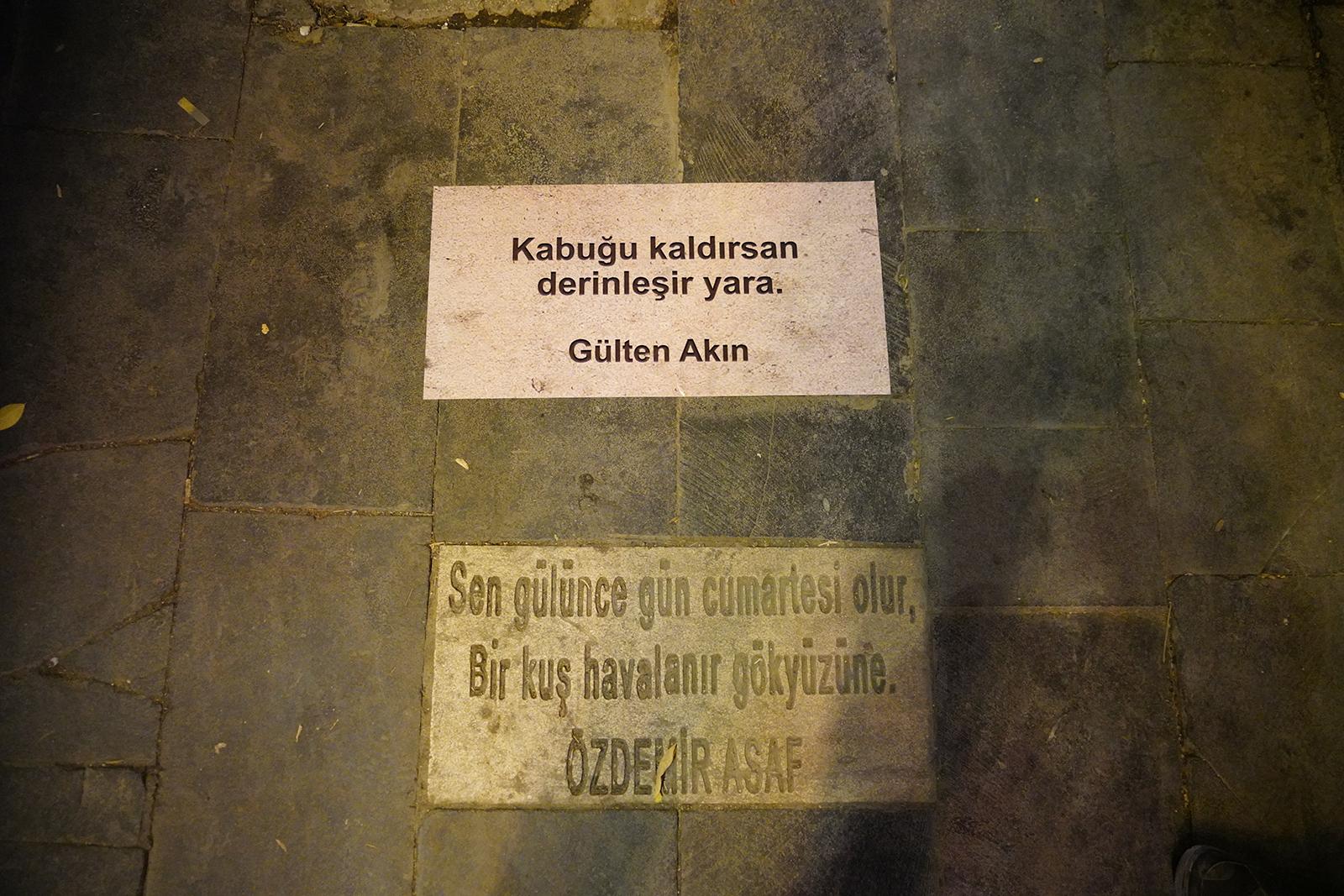
Canan Budak, “Enheduanna”, 22 pieces of 30x60, printed stickers, 2022
Twenty-five verses from different poems are located as relief paving stones on the right and left side of the main street of Mardin old city center. Canan Budak is intrigued by non of these poems’ belonging to female poets. While walking on these verses from male poets, the artist remembers how female poets that exist from Sumerian period until now have been disregarded as in any other field of art. She also associates the non-existence of women’s voice in the urban space with the neglect of women selected and assigned in local governments or work in NGOs. While gender equality needed to be campaigned for in the urban design councils, “woman having no name” in these literature interventions that has positive effects in city’s tourism potential, and no one raising voice on this issue is a malfunction.
In the intervention of the artist, selected verses of female poets that are recorded from Sumerians until now are printed on stickers and applied on pavement, a little up from the existing verses. Through their verses, women who are ignored in every field, poke this practice of neglect also repeated on the main street of the old city of Mardin.
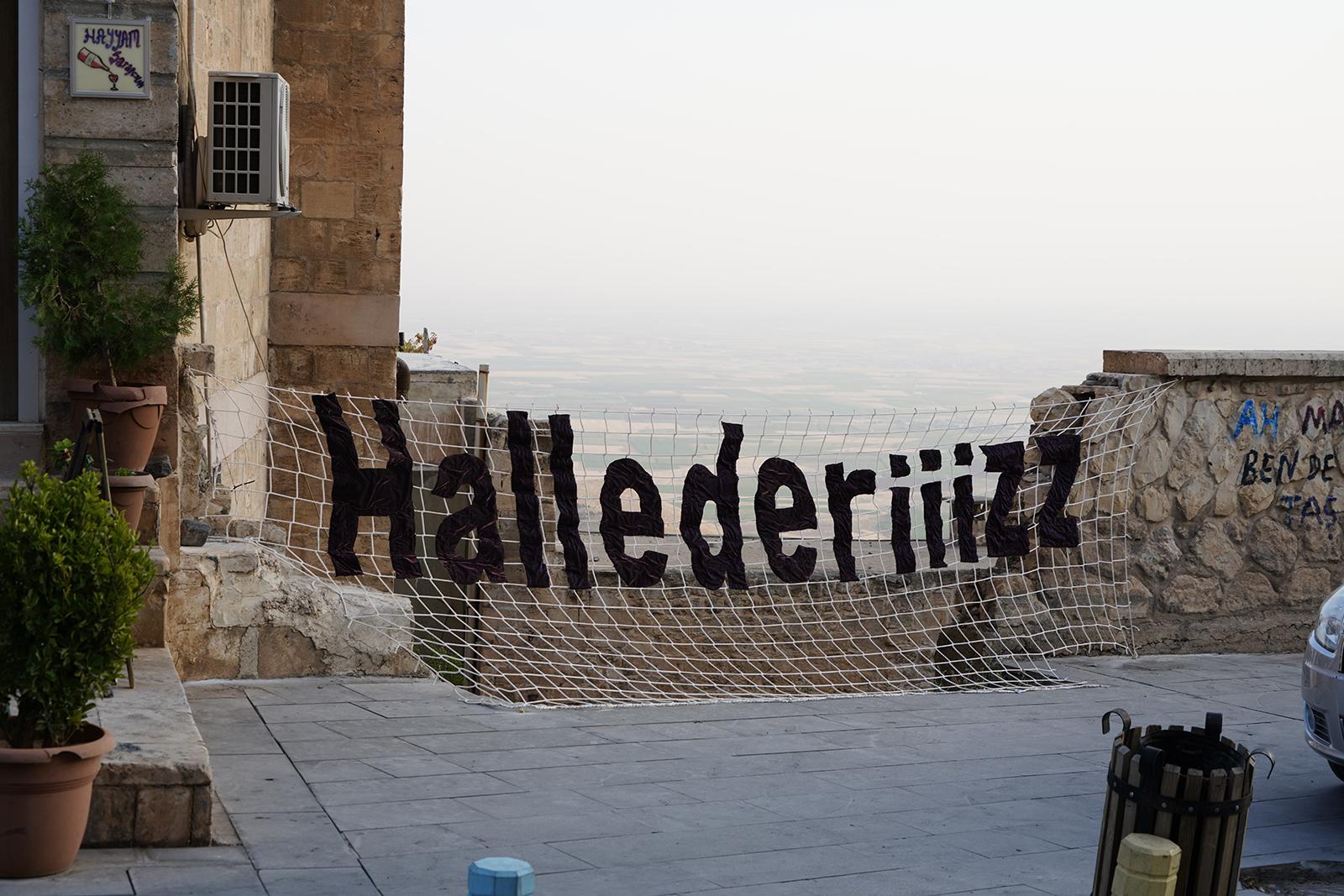
Dilan Demir, “Hallederiiizz” 250x540, safety net, fabric, 2022
The part of a retaining wall that fell down six years ago, on a heavily pedestrian route in the old city center of Mardin is chosen as the artistic intervention area. The lower part of the ruined wall is a ten-meter-deep void. No safety measures have been taken, and no warning signs has been placed on the wall, which poses a danger to pedestrians or stray animals. Concerns have been conveyed to local government many times by the residents of the city. Due to constant change in the government, any attempt of renovation has been constantly postponed and even forgotten with the phrase “we will handle it”. This phrase that is used by local governments in an aorist tense anytime facing urban problems, becomes the inspiration for the artist. She intervenes to that ruined part of the wall that she identified as an urban fault with a safety net. This net is chosen from the strong balcony nets that are used in high-rise buildings to ensure the safety of children and pets. It contrasts the remaining part of the retaining wall with its permeability and lightness, rendering the ruined part visible. Why do these urban ruins occur? How and when will they be fixed? A phrase, cut elaborately from a glittering fabric and sewn to the net is read on the safety net that is installed to draw attention to the ruined part of the wall: “We will handle it..”
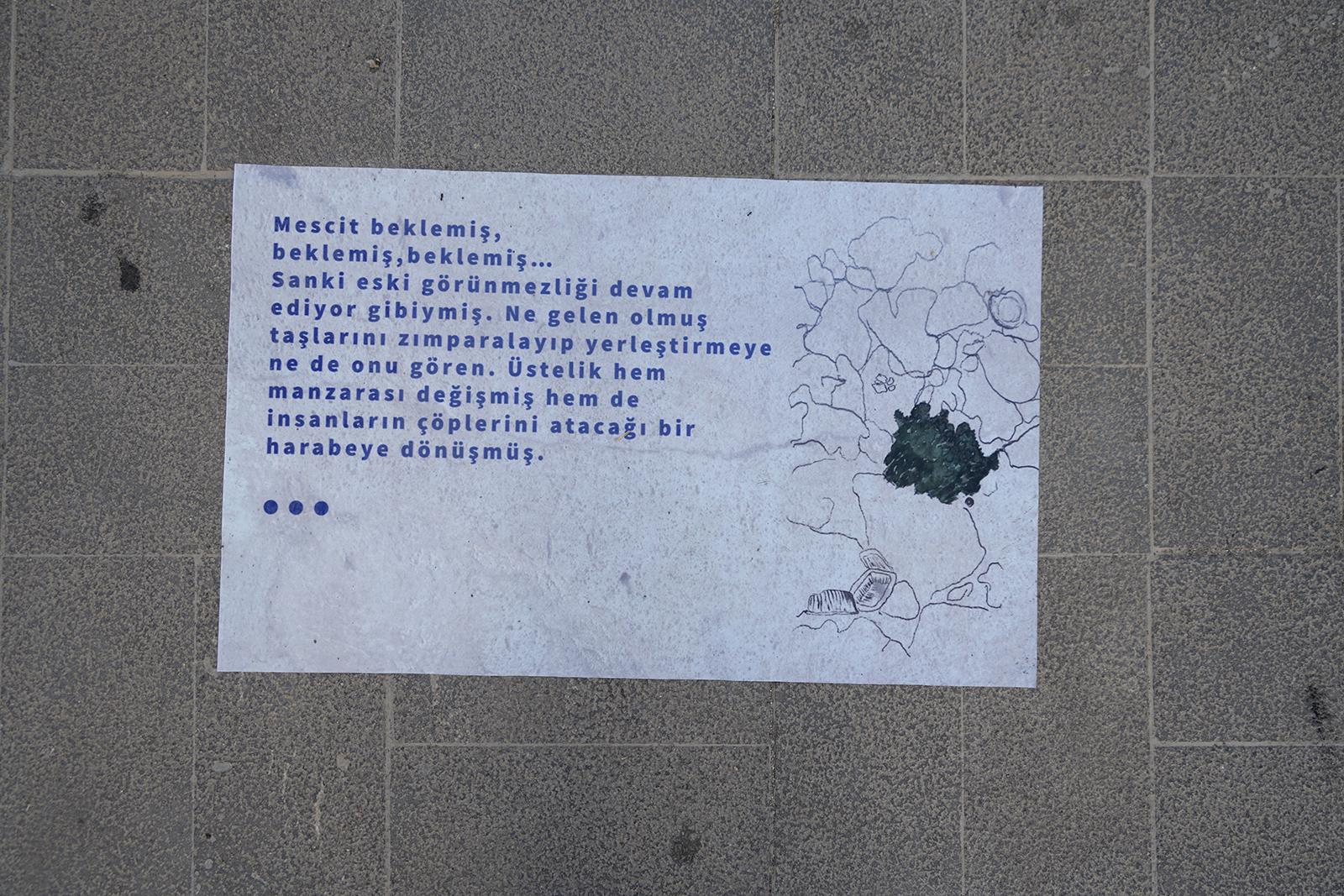
Ezgi Özten, “Ruins”, 12 pcs 45x60, printed stickers, 2022
In her work “Ruins” the artist writes a tale inspired from the moments of encountering the ruins of a mosque whose future is as enigmatic as its past, and which came to light with the collapse of a retaining wall due to heavy rain in 2018. The tale that is shaped through the artist’s observations of the space and experiences during her visits, is accompanied by delicate drawings. This dilapidated building is located right next to Mardin Artuklu University Faculty of Architecture. In this historic city that is under preservation, this building is becoming more devastated by the landslides. The artist approaches the covering up and revealing process of the building as an enigma; a building we were not even aware that it was there before, but whose devastated state we constantly confront now. In a way resembling magical realism in literature, she tells of a pigeon she encounters every time she visits the place. That pigeon is like a guardian of the place chasing anyone approaching the ruin. The pieces of the narrative printed on stickers are applied on the pavements leading to the building. The audience proceeds to the ruins of the mosque following the narrative on the sidewalk piece by piece. The desire of this work is to draw a road map on how to preserve this building which ironically locates right next to the Faculty of Architecture.
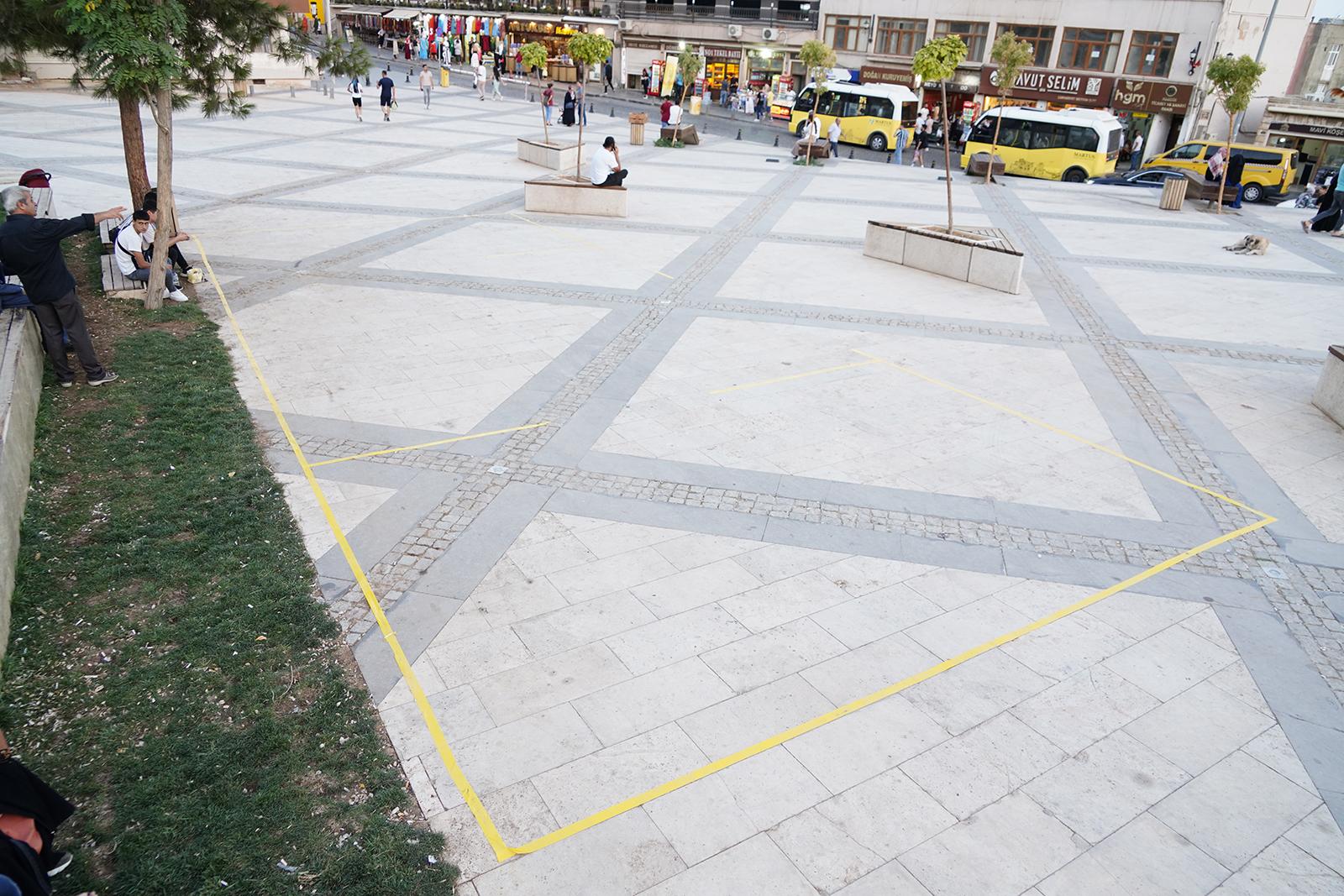
Sidar Alışık, “Trace”, 15mx6m, yellow tape, 2022
Republic Square that is located in the old city center of Mardin as the main square of the historical city, was formed, according to the resources, by the demolition of Patriarchate Church in 1915, during the demolitions of Germans for opening the Main Street. It was named as Republic Square in 1939 and changed functions in various thresholds. More recently the square, where concerts are also held, has been turned into a parking lot. The design project for the square which was announced and implemented in 2021 with labels like “compatible with the historic fabric” or “learning from history” indeed has a very weak connection with history. In her work, Sidar attempts to connect with a layer of the square’s history. As a gesture of remembering (remembrance) she tries to locate the demolished Patriarchate Church on the current grounds of the square. She chooses to mark the location of the church with tape band on the ground of the square, utilizing plan sketches developed from the photographs of the church transferred to present day. In this way, the existing space will be transformed through the act of remembering that is integrated with the past; layers of the past and present will meet to create a timeless spatial experience.
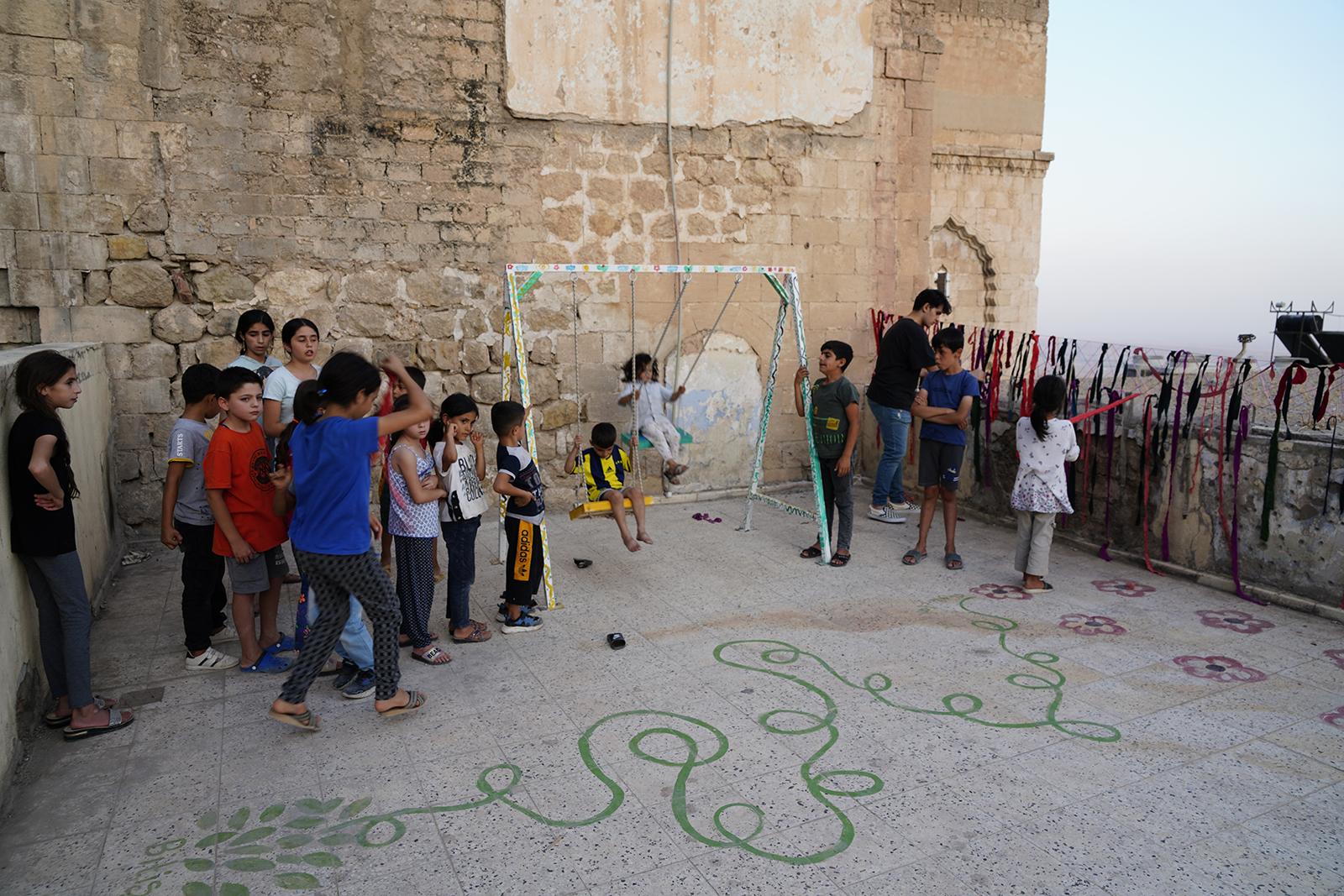
Büşra Akgeyik, “Dam park”, spatial installation, metal, wood, rope, paint, fabric, 2022
How do children interpret the concept of “malfunction”? How is it possible to create an urban intervention that acknowledge children as subjects of the city? Departing from these questions, painting workshops have been realized with children who live in Mardin and undertake certain responsibilities in and out of their homes, in their own neighborhoods. Children painted what they want to encounter as soon as they leave their homes; their dreams. Büşra Akgeyik, a special education teacher providing thematic art trainings for children in neighborhoods and at the museum, enquired children who are not conferred on the design of public spaces. The disconnection between the adult world and the children’s world reflected on the workshops from children’s perspective as the invisible habitants of the city.
Paintings of children who cannot reach an adequate number of art activities in the Historic Mardin, who are either employed part-time or helping house work and taking the responsibility of their siblings during the pandemic, are now being constructed into a playground: an embodiment of children’s own designs and imagination in a place where their needs are ignored and limited by the adult’s analytical world of numbers, signs or brands.
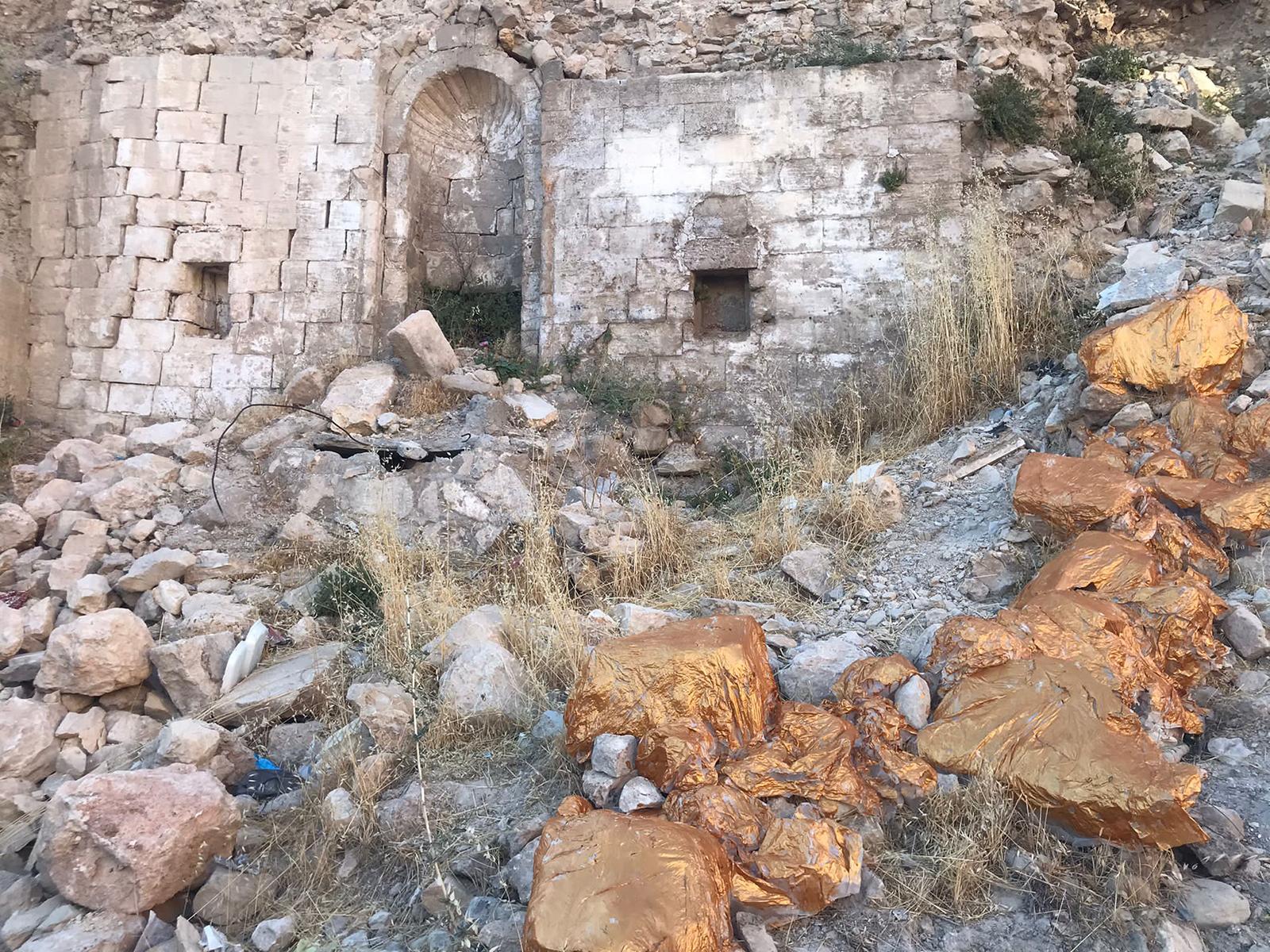
Yuvacan Atmaca, “Flowing Bonds”, installation, tracing paper, glue, paint, 2022
Until 500 million years ago the earth, an accumulation of material-energy as a soft tissue contingency, gave birth to the basic fabric of life through a mineralization process. Human skeleton is one of the many bifurcations that this process triggered. Creating a different mineralization process within this interactive energy flow, human population has built urban structures as an outer skeleton (De Landa, M., 1997, A Thousand Years of Nonlinear History, p: 25).
Humans, placing their own vitality and their own world at the center of both the world and vitality, are at the forefront of many crises including the ones of this century, by creating the greatest form of all, the city. The idea that these crisis are not actually related to the vitality and the world but to a human-centered world, constitutes the departing point of this work.
In this context, this work poses its question through a ruin that emerged as a result of a landslide, which is also related to climate change, in Mardin, a city whose history stands out with written meanings and built forms. This ruin is at the threshold where, the one that has gained form through human hand goes back to the world of rocks and stones, to the ambiguous darkness of the one that has not yet come to life, and which makes one think the totality of the earth’s material-energy flow. Stones in the ruin have become independent from the form they were placed in, due to the other energy flows to which they are connected. Liberated from form and meaning, and turned into an image space these stones and the formless (spineless) and temporary emergence built from tracing paper and glue both stand at this threshold. This work is not produced in order to give meaning to stone, or to beautify and give form to the ruin but to understand the stone.









This page is published on 9 November 2022.
Last update: 10 November 2022



